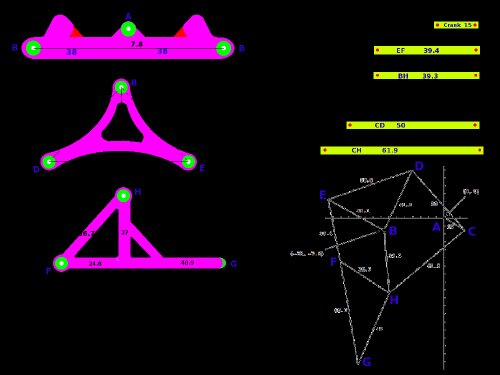We love the look, and most especially the gait, of [Theo Jansen’s] walker designs. We don’t fully understand them or the math behind them. But that could change if we spend enough time studying [Aaron Birenboim’s] body of work. He wants to incorporate the legs in a project so he’s been trying to optimize the Jansen leg design.
The calculations are delivered in a source code package available from his site. To make heads or trails out of the numbers you need a way to visualize them. He has provided that as well in the form of a MATLAB script which shows leg piece design and can even spit out an animated .gif file of the virtual legs in motion.
If you have no idea what we’re talking about make sure to check out [Jansen’s] original creations. We’re also excited to read more about the Klann and Ghassaei linkage designs which [Aaron] talks about in his post.

















Love the Jansen mechanism. Always think about making a walker with it. Maybe a knockoff of the Cajun Crawler. http://www.youtube.com/watch?v=JCPlczI3k-c
I made a klann walker, had matlab spit out all sorts of different configurations, and paths of the ending toe. it’s a good start for optimizing the klann mechanism
after naming each bar, and giving it an initial dimension, it’s easy to throw that into my code. how do i post/share it?
Kinetic horse. https://www.youtube.com/watch?v=y7usX-f97Os
Seems like this problem might be a good candidate for a genetic algorithm.
Related to this article – here’s a few different iterations of this machine: http://www.jcopro.net/2013/05/24/making-inspiration-the-strandbeest/
Weird that this came up right now – I just saw this article today. I’ve been working on my own version, so hopefully I’ll have something to show off soon!
Regarding my previous comment about using a genetic algorithm:
http://www.environmentalgraffiti.com/sciencetech/kinetic-beasts-netherlands/3242
it seems that the machines were designed with the aid of an evolutionary algorithm to begin withl.
” Jansen uses the principles of selection and evolution by running computer simulations to produce genetic algorithms that tell him which beasts are ‘fittest’ for the beach environment.”
Maybe I missed it, but I didn’t see the actual optimization process. The legs are remarkable, but I think the optimization may be the most important step, and it deserves more attention. As mentioned in the article, hidden factors like torque/rotation curve are really important, and the cumulative effect of all the linkages makes the tolerances of the joints highly critical to the final foot motion.
Those are relatively trivial to model in optimization code. Beyond the basic geometry, these structures can be given weight, deflection, cross sections (for wind, see Jansen’s originals), “springiness”, etc. The end result will probably give more realistic predictions than slight changes in the theoretical geometry.